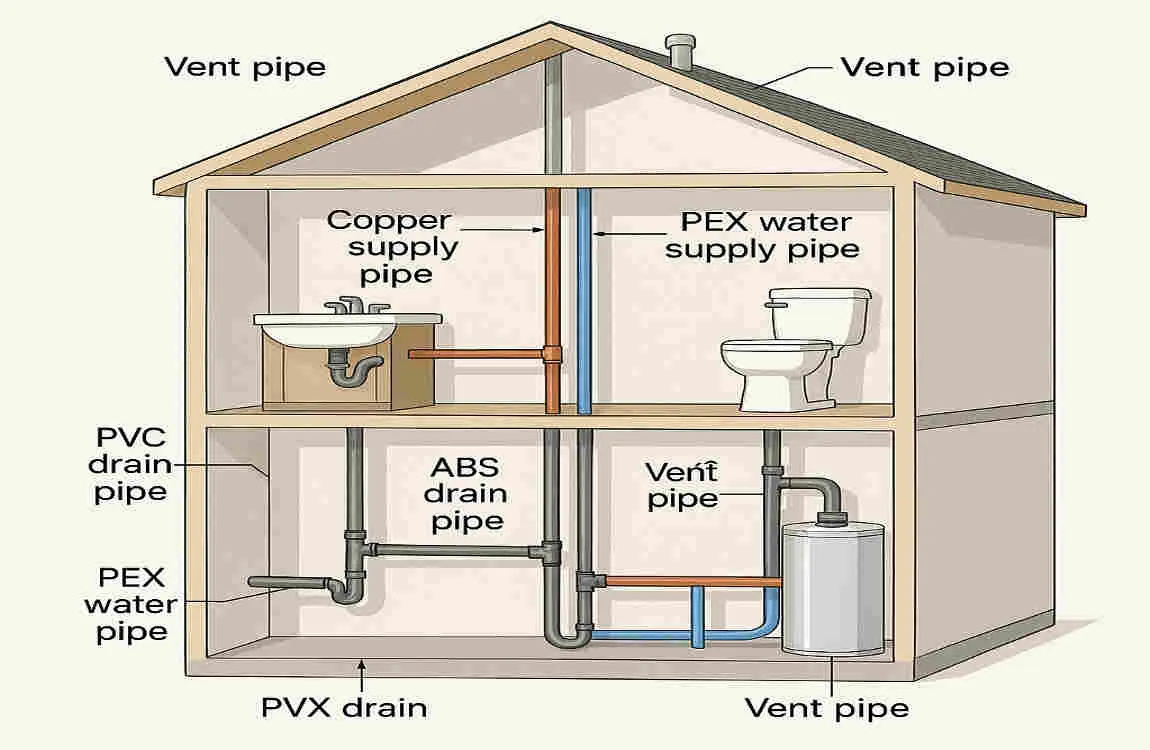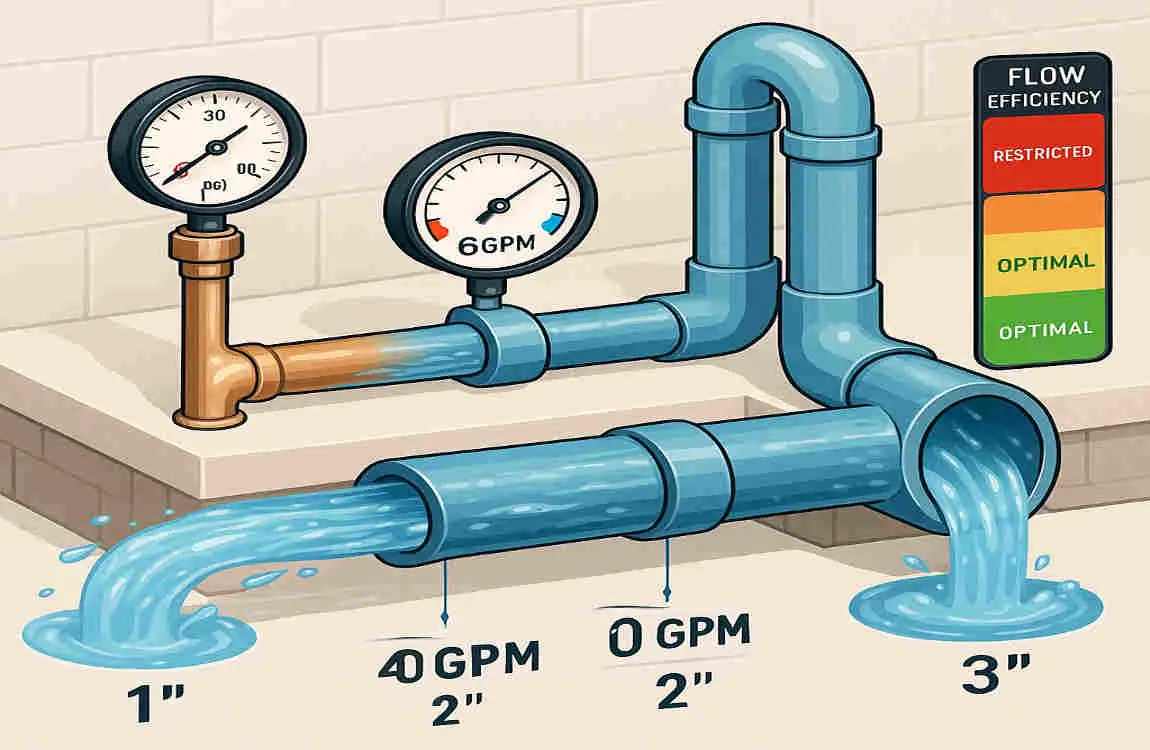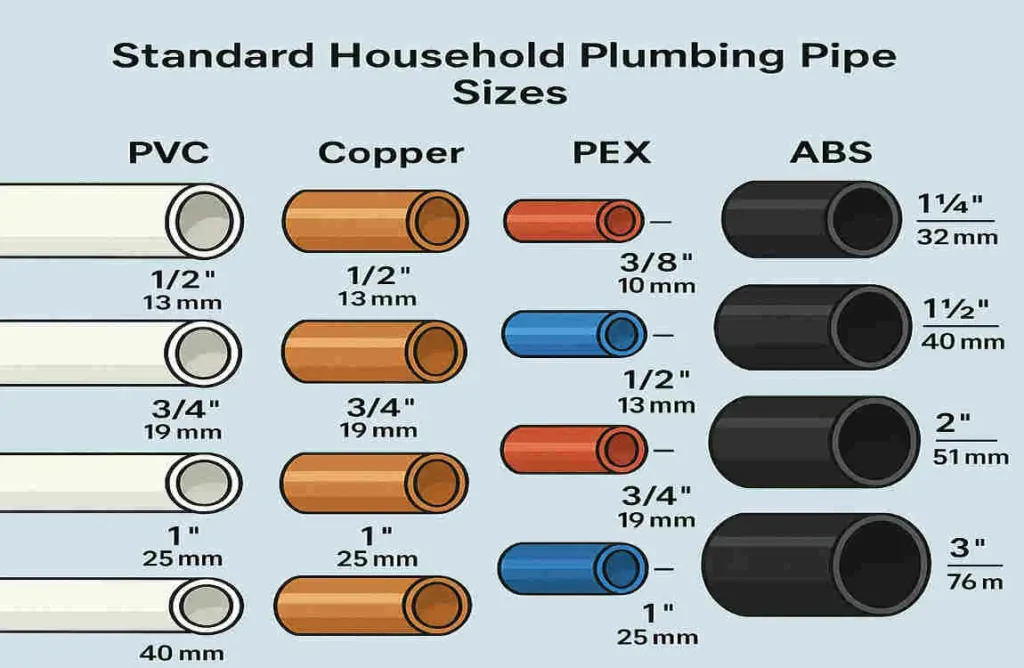Hey there, homeowner or DIY fan! Have you ever stared at a leaky faucet or planned a bathroom remodel and wondered about the pipes hiding behind your walls? You’re not alone. Knowing the right household plumbing pipe sizes can save you time, money, and a whole lot of headaches. Whether you’re fixing a drip or installing new fixtures, understanding these sizes helps ensure everything flows smoothly—literally.
We’ll start with the basics, cover standard sizes for different parts of your home, and share tips to help you choose wisely. By the end, you’ll feel confident tackling your next plumbing project or knowing when to call in the pros. Let’s get started!
Understanding the Basics of Household Plumbing Pipes

Plumbing might seem like a mystery, but it all boils down to pipes that carry water in and out of your home. Let’s break it down simply.
What Do We Mean by Pipe Sizes?
When we talk about household plumbing pipe sizes, we’re referring to the diameter of the pipe—how wide it is inside. This isn’t just a random number; it affects how much water can flow through.
Pipes have a “nominal size,” which is like a label (say, ½ inch), but the actual inside diameter might be a bit different due to the pipe’s wall thickness. For example, a ½-inch copper pipe might actually measure about 0.625 inches inside. Don’t worry if that sounds confusing—most hardware stores use nominal sizes, so you can shop with those in mind.
Why does this matter to you? The right size ensures your water pressure stays strong and waste drains away without backups. Imagine trying to sip a thick milkshake through a tiny straw— that’s what happens with undersized pipes!
Types of Pipes in Your Home
Homes use different materials for pipes, each with its own strengths. Copper pipes are durable and great for hot water. PVC (that’s polyvinyl chloride) is lightweight and common for drains because it resists corrosion.
Then there’s PEX, a flexible plastic that’s easy to install and popular in modern homes. Older houses might have galvanized steel pipes, which are sturdy but can rust over time.
Each type comes in standard sizes, but the material affects how you work with them. For instance, copper is rigid, while PEX bends like a garden hose—making it a DIY favorite.
Supply Lines vs. Drain Pipes: Key Differences
Think of your plumbing as two teams: one for bringing clean water in (supply lines) and one for taking dirty water out (drain/waste pipes).
Supply lines are usually smaller because they handle pressurized water. Drain pipes? They’re bigger to let gravity do the work and prevent clogs.
Vents are part of the drain system too—they let air in to keep things flowing smoothly. We’ll cover sizes for all these soon. Stick with me, and you’ll see how they fit together in your home.
Common Standard Household Plumbing Pipe Sizes for Water Supply Lines
Now, let’s focus on the pipes that deliver water to your taps and appliances. These are your supply lines, and getting the size right is crucial for sound pressure.
You may also read (how to choose a pressure boost shower head for your home).
The Usual Suspects: ½ Inch, ¾ Inch, and 1 Inch
Most homes use pipes in these three sizes for the water supply. A ½-inch pipe is standard for smaller branches, while ¾-inch handles more demand, and 1-inch is for the main lines.
Picture this: Water enters your home through a central line, often ¾ inch to 1 inch wide. It then branches out to fixtures like sinks or showers.
Why these sizes? They balance flow rate—how much water moves per minute—with efficiency. Too small, and your shower feels like a trickle; too big, and you’re wasting material.
Where Each Size Fits in Your Home
Branch lines, which split off from the main supply, are typically ½ inch or ¾ inch. These feed groups of fixtures, like all the bathrooms on one floor.
The main water supply line? That’s usually ¾ inch to 1 inch, depending on your home’s size and water needs. Larger homes with multiple bathrooms might need that full inch to keep pressure steady.
For individual fixtures, supply tubes get even smaller—often 3/8 inch for faucets, toilets, and sinks. These connect the branch line right to the fixture.
Real-Life Examples and Why They Matter
Take your kitchen sink: It might use a ½-inch branch line for hot and cold water. But the toilet? A 3/8-inch supply tube is standard because toilets don’t need constant high flow—they just fill the tank quickly.
What about regional differences? Building codes vary by location. In areas with low water pressure, you might need larger pipes to compensate. Always check your local rules to avoid costly mistakes.
Selecting the correct household plumbing pipe sizes prevents pressure drops. Low pressure means weak showers, and nobody wants that! It also ensures efficient flow rates, keeping your water bills in check.
Standard Sizes for Household Drain, Waste, and Vent (DWV) Pipes
Shifting gears, let’s talk about the pipes that handle the dirty work: drains, waste, and vents. These are bigger than supply lines for a reason.
Why Drain Pipes Are Larger
Drain pipes rely on gravity, not pressure, so they need more room for waste and water to flow without backing up. Standard sizes range from 1 ¼ inches to 4 inches.
Unlike supply pipes, these aren’t under constant pressure. They’re designed to handle occasional surges, like when you flush or drain a tub.
Breaking Down Sizes by Use
For toilets, you’ll see 3- to 4-inch drain pipes. Why so big? Toilets produce a lot of waste quickly, and a wide pipe prevents clogs.
Sink drains are smaller: 1 ¼ to 1 ½ inches. That’s enough for everyday use without overkill.
Bathtubs and showers typically use 1 ½ to 2 inches of water. Showers might need the extra width for faster drainage during long rinses.
The central drain or sewer line? That’s often 4 inches, connecting your home to the city’s system. It’s the highway for all your waste.
The Unsung Heroes: Vent Pipes
Vent pipes are crucial—they prevent vacuum effects that could slow drainage or cause gurgling sounds. Typical sizes match the drains they serve, like 1 ½ inches for a sink vent.
Their purpose? To let air into the system, keeping pressure balanced. Without vents, your drains might suck air from traps, allowing sewer gases into your home. Yuck!
Proper sizing here follows building codes, ensuring your system works safely and efficiently.
How to Determine the Right Pipe Size for Your Plumbing Project
Feeling overwhelmed? Don’t be. Choosing the right household plumbing pipe sizes involves a few key factors. Let’s walk through them step by step.
Key Factors to Consider
First, think about fixture unit ratings. What’s that? It’s a way to measure how much water a fixture uses. A toilet might be 3 units, a sink 1 unit.
Add up units for all fixtures on a line to pick the pipe size. Distance from the water source matters too—longer runs need bigger pipes to maintain pressure.
Water pressure and needed flow rate play a role. High-demand areas like kitchens might require larger sizes.
Explaining Fixture Units Simply
Fixture units help predict demand. For example, a shower is about 2 units, and a washing machine is about 3 units. Charts (we’ll reference some later) show what pipe size handles a certain number of units.
This system ensures your pipes aren’t overwhelmed during peak use, such as during peak showering times before work.
Using Charts and Professional Tips
Look up pipe sizing charts for appliances. A toilet needs at least a ½-inch supply for 3 units, but drains are bigger.
Practical advice: Always consult local building codes—they dictate minimum sizes. If in doubt, chat with a plumber. They can assess your setup and recommend based on real-world factors.
Remember, reader, measuring your current pipes and flow rates at home can give you a head start. Grab a tape measure and note what you have!
Common Pipe Sizes According to Material Type and Usage
Not all pipes are created equal. The material influences standard sizes and where they’re used. Let’s explore.
Copper Pipes: The Classic Choice
You may also read (what is the best way to stain house plywood).
Copper shines in water supply, with ½-inch and ¾-inch being the most popular sizes for households. They’re rigid, resist corrosion, and handle hot water well.
In older homes, you might find 1-inch copper for mains. It’s pricier but lasts decades.
PVC Pipes: Drainage Pros
PVC rules for drains and vents, in sizes from 1 ¼ to 4 inches. It’s cheap, easy to cut, and won’t rust.
Common in modern builds for its simplicity. Just glue joints, and you’re set—no soldering needed.
PEX Piping: Flexible and Modern
PEX comes in ½-inch, ¾-inch, and 1-inch for supplies. Its flexibility means fewer fittings, speeding up installs.
Great for retrofits—snake it through walls without tearing everything apart. Sizes match copper for compatibility.
Galvanized or Steel Pipes in Older Homes
These are found in vintage houses, often ½ to 1 inch for supplies. They’re laborious but prone to rust, so many have upgraded to modern materials.
Modern systems favor PVC or PEX for efficiency. If your home has steel, check for corrosion before sizing new additions.
Choosing by material? Match what’s already there for seamless connections, or upgrade for better performance.
How Pipe Size Impacts Plumbing Performance and Efficiency

Size isn’t just about fitting—it’s about how your system performs. Let’s see the real effects.
Water Pressure and Flow Rate Basics
Incorrect household plumbing pipe sizes can mess with pressure. Too small? Water struggles to flow, causing low pressure and slow fills.
Too large? You might get good flow, but it costs more upfront, and water can stagnate, leading to bacterial growth.
Balance is key. Proper sizing keeps pressure steady and flow efficient, saving water and energy.
Risks of Undersizing
Imagine undersized pipes: Your shower dribbles while the washing machine runs. It strains pumps and wastes time.
Worse, it can lead to bursts under high demand. Avoid this by calculating needs accurately.
Oversizing Pitfalls
Big pipes sound great, but they increase material costs and can cause water to sit, potentially freezing in cold climates.
They also complicate installations. Stick to codes for a sweet spot between cost, efficiency, and compliance.
Hey, you—next time you’re planning, think about long-term savings. The correct sizes mean fewer repairs and happier plumbing!
Practical Examples of Household Plumbing Pipe Sizes by Fixture
To make this concrete, here’s a handy table of typical sizes. Use it as a quick reference for your projects.
Fixture Supply Pipe Size, Drain Pipe Size, Why This Size?
Toilet 3/8 inch 3-4 inches Quick tank fill; handles large waste volume.
Bathroom Sink 3/8 inch 1 ¼ inches Low flow needs; prevents minor clogs.
Shower ½ inch 1 ½ inches Steady pressure for spray; fast drainage.
Kitchen Sink ½ inch 1 ½ inches Higher demand for washing; grease tolerance.
Washing Machine ¾ inch 2 inches High volume cycles; quick emptying.
Water Heater ¾ inch N/A (varies) Efficient hot water distribution.
See how sizes vary? Fixtures with high demand, like washers, need bigger pipes to avoid backups.
For a list of quick tips:
- Match to demand: Toilets need big drains for solids.
- Consider location: Basements might require larger mains.
- Upgrade wisely: If remodeling, size up for future needs.
These examples show why one size doesn’t fit all—tailor to your home’s setup.
Tips for Homeowners and DIY Enthusiasts When Working with Plumbing Pipes
Ready to get hands-on? Here are some friendly pointers to keep you safe and successful.
Measuring Accurately
Grab a caliper or tape for outside diameter, then check charts for nominal size. For insides, use a ruler on cut ends.
Accuracy prevents mismatches. Measure twice, buy once!
Ensuring Compatibility
New pipes must fit old ones. Use adapters if switching materials, like from copper to PEX.
Test connections before sealing walls—leaks are easier to fix early.
When to Call a Pro
DIY is great for small jobs, but complex sizing or code issues? Call a plumber. They spot problems you might miss.
It’s worth the cost for peace of mind, especially with water damage risks.
Following Codes and Standards
Local building codes aren’t suggestions—they’re musts. Ignoring them can void insurance or lead to fines.
Research online or ask your city hall. Stay compliant, and your system will last.
You got this, reader! Start small, and build your confidence.
Summary and Best Practices for Choosing Household Plumbing Pipe Sizes
We’ve covered a lot: From basics to specific sizes, materials, and impacts. Remember, household plumbing pipe sizes ensure efficient, safe systems.
Key takeaway: Proper sizing boosts performance, cuts costs, and prevents issues. Recap: Supplies are ½-1 inch, drains 1¼-4 inches, varying by fixture and material.
Best practices? Calculate fixture units, consult charts, and follow codes. Prioritize efficiency for long-term wins.
Always seek professional advice for big projects—it’s smart, not a cop-out.
You may also read (how does stacking improve in house plumbing systems).

